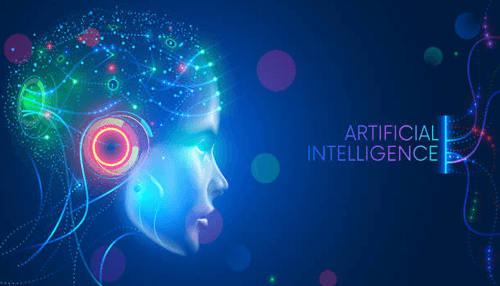Introduction to Artificial Intelligence (AI)
Artificial Intelligence (AI) is the simulation of human intelligence in computers, and they are trained to think and act in the same way as humans do. It can also refer to any computer that demonstrates human-like characteristics such as problem-solving and learning.
The ability of Artificial Intelligence to reason and act and achieve a specific goal is the ideal trait. Machine learning is a subset of Artificial Intelligence that relates to the concept of computer systems learning and adapting to new data without the need for human intervention. Deep learning algorithms enable this self-learning by absorbing large amounts of unstructured data such as text, images, and video.
History
Artificial Intelligence (AI) was first coined in 1956, but because of increased data volumes, improved algorithms, and computer power and storage advances, AI is becoming more common today.
In the 1950s, early AI research focused on problem-solving and symbolic approaches. The US Department of Defense became interested in this type of work in the 1960s and began teaching computers to emulate fundamental human reasoning. In the 1970s, the Defense Advanced Research Studies Agency (DARPA), for example, undertook street mapping projects. And, long before Alexa, Cortana, or Siri became household names, DARPA developed intelligent personal assistants in 2003.
This pioneering work opened the path for today’s computers to automate and formalize thinking, such as decision support systems and smart search engines, which can be built to complement and augment human talents.
While Hollywood movies and science fiction novels portray AI as humanoid machines that take over the world, the current state of AI technology isn’t nearly that frightening – or as intelligent. Instead, AI has evolved to give a wide range of benefits across all industries. Continue reading to learn about modern applications of Artificial Intelligence in fields such as retail, health care, and more.
Understanding Artificial Intelligence (AI)
When most people hear the word Artificial Intelligence, they immediately think of robots. Because large-scale films and novels are the tissues of ravaging human-like machines on Earth, however, the truth could not be further from the truth.
AI stands for Artificial Intelligence. Artificial Intelligence is based on the idea that human intelligence can be described in a way that allows a computer to imitate and accomplish tasks ranging from simple to complex readily. The goal is to mimic human cognitive functions.
Researchers and developers in the field are making substantial progress in replicating processes such as learning, reasoning, and perception so that they can be articulated in practice. Some believe that inventors may soon be able to create systems that go beyond the human ability to learn or comprehend any subject. Others, on the other hand, are skeptical because value judgments are embedded in all cognitive activities.
As technology advances, previous Artificial Intelligence definition criteria become obsolete. Machines that can perform simple computations or recognize texts by recognizing optical characters, for example, are no longer considered synthesis because this function is considered to be a natural computer.
AI is constantly evolving in a variety of fields. An interdisciplinary strategy based on computer science, mathematics, languages, psychology, and other disciplines is used to connect machinery.
Types of Artificial Intelligence
There are 4 types of Artificial Intelligence that you should about before undergoing AI ML training. They are as follows:
1. Reactive machines:
The most fundamental level of robotics is reactive machines. They can simply react to the current situation, but they can’t remember things or apply what they’ve learned to influence future behaviors. IBM’s Deep Blue demonstrates this.
A computer was developed to play chess against humans. Deep Blue evaluates and reacts to chessboard portions using a pre-programmed chess strategy. Because it does not learn or evolve while playing, it can only be regarded as “reactive.”
2. Limited Memory:
As the name implies, a limited memory computer can preserve information from prior events or data. It can use this memory in conjunction with preprogrammed data to build knowledge.
Self-driving cars, for example, include pre-programmed data such as lane markings and maps and monitoring information on the speed and direction of other cars and people moving around them. These vehicles can assess their surroundings and adapt their driving accordingly.
Machine decision-making response times have improved as technology has advanced, which is a critical technological component as potentially disastrous as self-driving cars. Machine learning advancements also assist autonomous vehicles in learning to drive in the same way that people do — through practice over time.
3. Theory of mind:
People’s thoughts, feelings, memories, and other brain processes influence and drive their behavior. The goal of mental research theory studies is to construct computers that can emulate human mental modeling.
To put it another way, machines comprehend why people and animals have thoughts and feelings that influence their own behavior. This mental concept enables humans to interact socially and form societies.
People’s expertise should be learned by the theory of mind robots, which would subsequently inform how the machine communicates or reacts to new situations.
4. Self-awareness:
AI machines are the most complex machines we’ve ever imagined, and some have dubbed them “AI’s ultimate objective.” These are machines that are aware of their surroundings and have a sense of humanity.
“I want a glass of water” is not the same as “I know I need a sip of water,” they just don’t ask. They are aware that they require it. As a conscious human, this machine would be aware of its own internal state as well as anticipate the feelings of those around it.
For example, if someone yells at us, we assume they are upset since that is how we react when we yell. We wouldn’t be able to draw these conclusions from other people if we didn’t have a theory of mind.
Why is Artificial Intelligence crucial?
1. AI automates the process of repeat learning and data discovery. However, AI is not the same as robotic automation, which is controlled by hardware. Instead of automating manual procedures, AI performs regular, high-volume, automated actions reliably and without getting fatigued. Human inquiry is still required to set up the system and ask the right questions for this type of automation.
AI uses deep, previously inconceivable neural networks to attain incredible precision. For example, you have a deep awareness of your interactions with Google Search, Alexa, and GP photographs – and the more precise we use them, the better we understand them. Deep learning, image classification, and object recognition algorithms in the medical field can now detect cancer in MRIs with the same accuracy as highly trained radiologists.
2. By using progressive learning algorithms, AI adapts to allow data to be programmed. The AI system learns competency by discovering the structure and regularities of the data. As a result, the algorithm can teach itself to play chess, and the next product can be promoted on the internet.
When new data is presented, the models are updated. Returning the propagation is an AI approach and can be tailored to the model when the first response isn’t completely perfect.
3. To analyze more and more complex data, AI employs neural networks with several hidden layers. It was nearly impossible to construct a fraud detection system with five hidden levels just a few years ago.
Everything has changed as a result of incredible computing power and massive amounts of data. Deep learning algorithms learn directly from data. Therefore they require a lot of data to train. The more data you can feed it, the more precise it will be.
4. The vast majority of AI data is gathered efficiently. When algorithms learn on their own, the data itself might become intellectual property. To retrieve them, you’ll need to use AI technology. Then, their responses are stored in the database.
Data function is more important than ever now, and it can be used to gain a competitive advantage. Even if everyone follows the same methods, you receive the best results in a competitive firm if you have the most data.
5. AI adds intelligence to existing products. In many cases, AI is not sold as a single application. Since Siri has been integrated into a new generation of Apple products, you will instead update goods that already have AI capabilities.
A large amount of data may be integrated to improve a variety of technologies at home and work, including security intellectuals and investment analytics.
Conclusion
Artificial Intelligence (AI) is redefining commercial processes such as marketing, medical services, financial services, and more in a variety of industries. Companies are always looking for new ways to use technology to help them.
As the demand for better-existing procedures grows, professionals with AI skills should be able to find work. To gain more knowledge about Artificial Intelligence, there are a lot of AI courses online that you can pursue.
References
https://www.investopedia.com/terms/a/artificial-intelligence-ai.asp
https://www.sas.com/en_in/insights/analytics/what-is-artificial-intelligence.html



